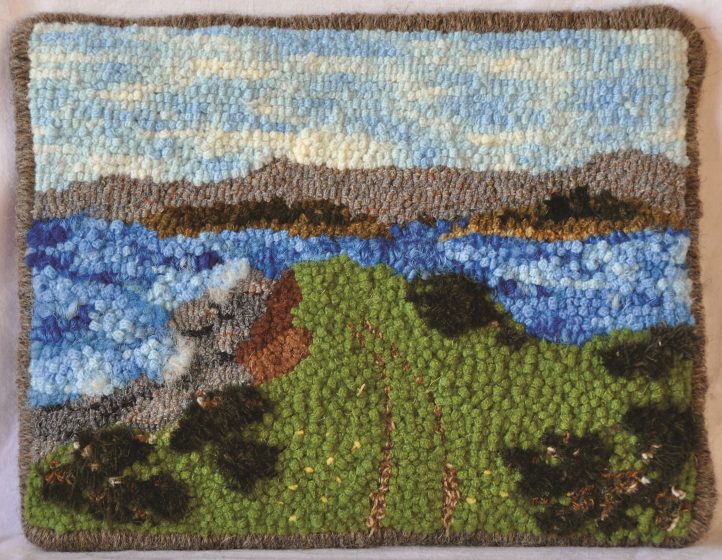
Road to Black Point, 71/2″ x 9″, #3- and 4-cut wool on linen. Designed and hooked by Aileen Ross, Trenton, NS, 2008. Aileen hooked this view, which can be seen from a vantage point near her house, from memory. She used recycled and new wool in most of the mat, but hooked the water in fleece. She was pleased with how the fleece changed the look of the water, but she found that fleece was very hard to hook when compared to wool.
Last year, my rug hooking group, the Harbour Hookers, decided to hook small mats that we affectionately called Harbour Vignettes. A “vignette” is defined as a small scene that captures or freezes a moment or idea. Little Harbour—a fishing and farming community founded 225 years ago when Scottish soldiers who fought in the American War of Independence were given grants of land in Nova Scotia—presents its share of vignette subjects. The town lies tucked away on the north shore of Nova Scotia, the easternmost part of mainland Canada. On a map, the province juts out into the Atlantic Ocean like a giant lobster claw ready to grab whatever crawls out of the sea.
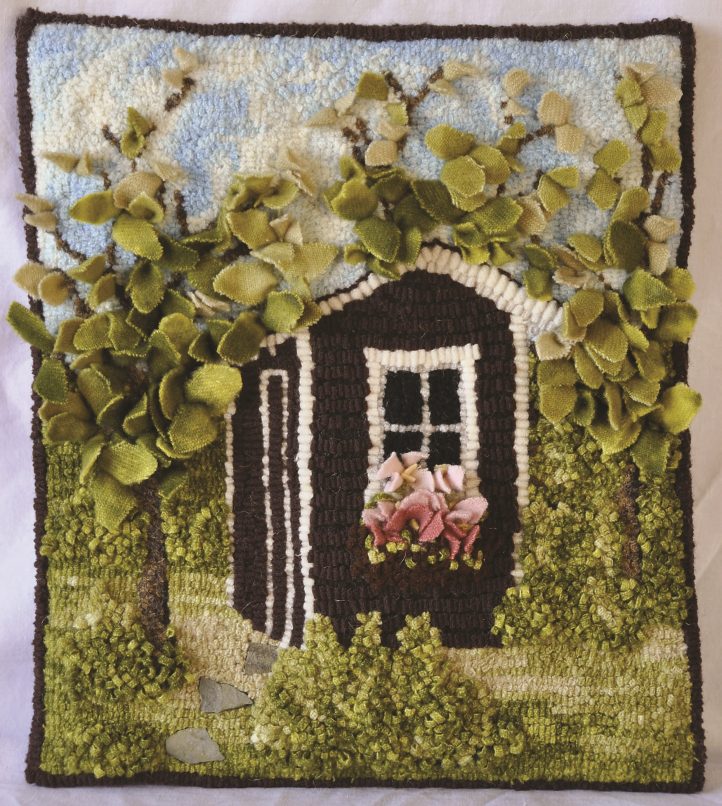
The Potting Shed, 10″ x 12″, #3-, 4-, and 5-cut wool on linen. Designed and hooked by Aileen Ross, Trenton, NS, 2008. Jean Church spent her summers in a brown cottage with white trim overlooking Black Point. Her furniture was painted in primary colors and her floors were covered with hooked rugs. After her death, Aileen acquired the property and built a year-round home. She saved the outhouse from demolition and turned it into a unique potting shed with lots of character. The original cottage and outhouse were built in a style of construction known as shiplap. Aileen drew her pattern on paper first and then transferred it onto the backing. Hooking the shiplap construction required some additional planning. Aileen eventually settled on hooking high and low loops to show the over-lapping boards. She used proddy hooking for the leaves and flowers.
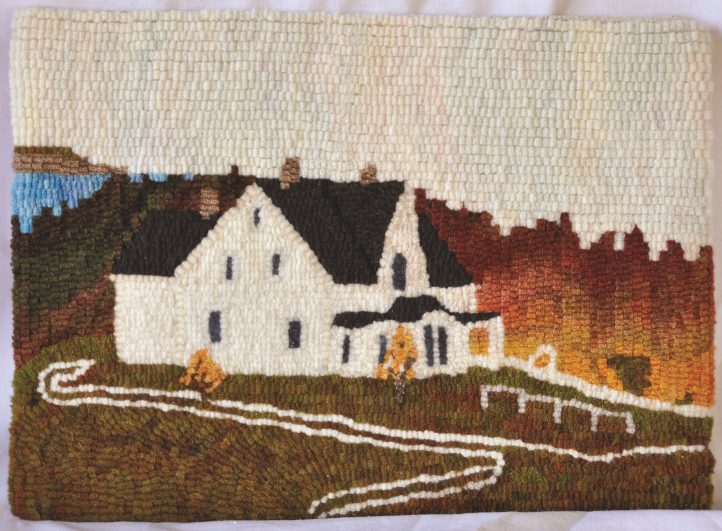
Rose Heath, 8″ x 11″, #5-cut wool on linen. Designed and hooked by Carol Forbes, New Glasgow, NS, 2008. Rose Heath goes back to the early 1800s. Belonging to the Forbes family, it was noted for its many parties. Carol created her pattern for this mat from a black-and-white photo, and it was hooked with wool that she had on hand.
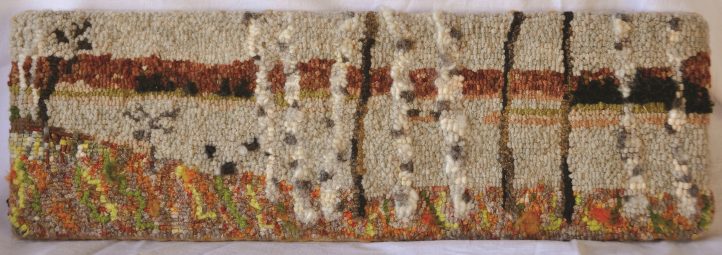
View from Ted’s Beach, 5″ x 16″, #3-, 4-, and 5-cut on burlap. Designed and hooked by Anne-Renee Nowlan, New Glasgow, NS, 2008. Anne-Renee chose to hook a view from her property. She used a photo to plan out the mat’s design and its colors. She decided to hook the trees higher to give the illusion that they were in the foreground. The piece hangs from a white birch branch.
Some of the members of the Harbour Hookers were born and raised in Little Harbour, others are summer-cottagers-turned-year-rounders, and a few arrived after marrying a Harbour man. We all enjoy the ebb and flow of our rural life by the ocean; in fact, each one of us can see the water from our homes. It’s a rare hooking session that doesn’t include a comment about the water.
So it came as no surprise that many of our vignettes include water. We are all witnesses to not only the infinite number of blues, but also how many moods blue can portray. Would the water be an angry muddy blue of the north wind or the sparkling blue tide pools of a clam-digging summer day? Would the blues in the sky be the soft autumnal light bouncing from red and yellow birch leaves or the overcast slate-gray sky of a rainy April day? We were prepared to experiment with the dye pot to capture these blues, but the owner of a recently-opened wool shop had just created several different “Nova Scotia” waters and “Nova Scotia” skies. Suddenly, we had lots of choices for our many maritime moods.
The discussion of what to hook went on for days. We had two criteria: it had to be small (hoop-size) and it had to evoke a special memory about life in our hometown of Little Harbour. Each vignette idea multiplied into two or three more as old photographs surfaced and we scoured local history books. Eventually, the ideas seemed to fall into two categories: architecture and views.
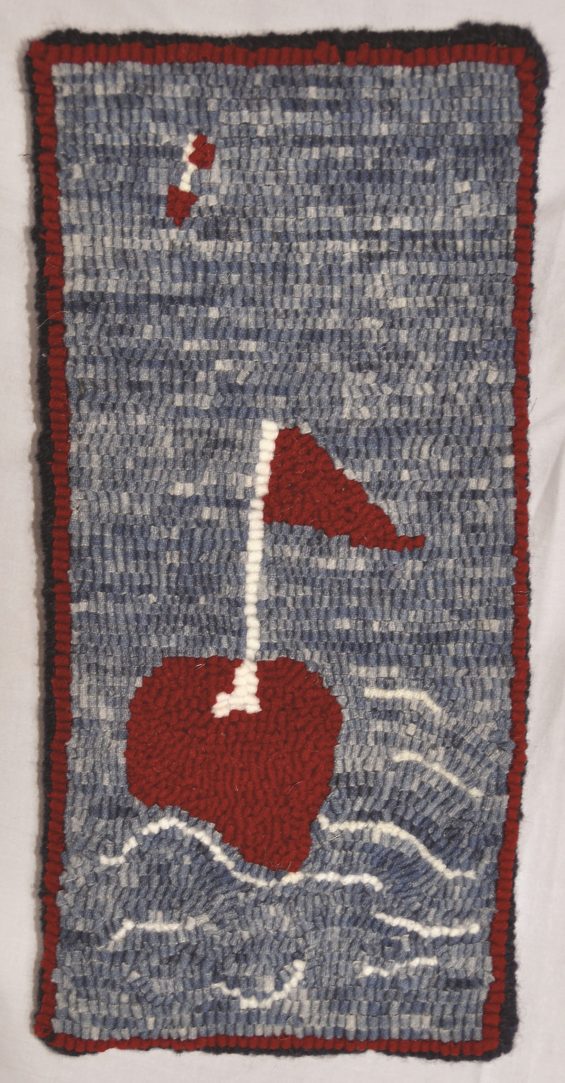
The Buoys, 63/4″ x 14″, #3-, 5-, and 6-cut wool on burlap. Designed and hooked by Audrey Hemphill, Trenton, NS, 2008. Audrey has fished lobsters in the Little Harbour area for most of her life, first with her father and later with her husband, and then as a widow with small children at home. Each spring the boat and buoys were painted and the traps prepared for the two-month lobster season. To distinguish their lines from other fishermen’s lines, she and her husband painted their buoys red with white stems and red flags. As a child, she remembers making lobster traps. The men gathered juniper in the spring and steamed the wood in a half-moon-shaped jig over an open fire. They added mesh headings knit with a wooden needle and heavy cotton. Rocks picked from the beach provided the weight to sink the traps. In the 1920s and 1930s her father put out nine hundred traps that had to be hauled in by hand. That was when lobster sold for five cents a pound. Audrey still goes out fishing once or twice a season and chuckles about how much lobster fishing has changed over the years. Now the traps come ready-made—some are even made from steel, although she claims the wooden ones are the best for catching lobsters. Haulers pull the soaking wet traps on board, and lobsters sell for five dollars a pound. One thing, however, that has not changed is the starting time to pull the traps: 5:30 a.m. The most challenging part of creating this mat was finding blue wool for the water. She eventually purchased blue wool; the red and white wools were recycled wools. To make the second buoy look like it was farther away, she hooked it with a smaller cut.
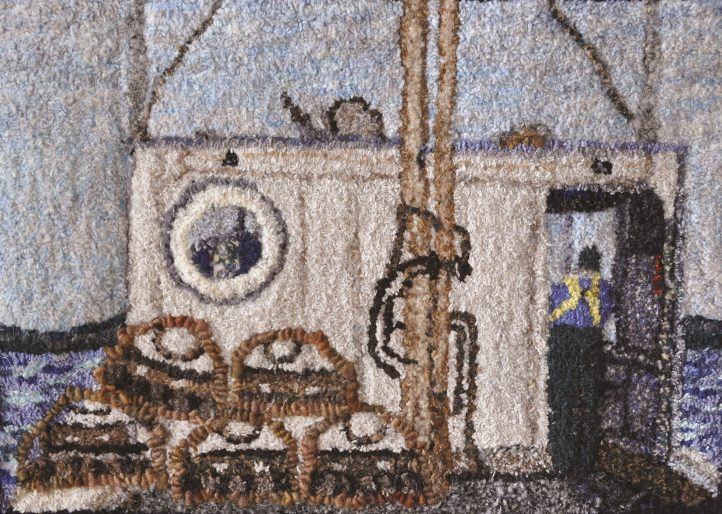
Lobster Fishing off the Point, 12″ x 9″, #3-cut wool on linen. Designed and hooked by Margaret MacKay, Trenton, NS, 2008. Margaret chose to “paint” a day of lobster fishing in her vignette. She used photos from her voyage to create this view of the deck. After hooking, she clipped, trimmed, and embossed the loops. Fleece makes the lobster traps stand out from the deck. Her biggest challenge was getting the color of the lobster boat just right so it wouldn’t fade into the sky.
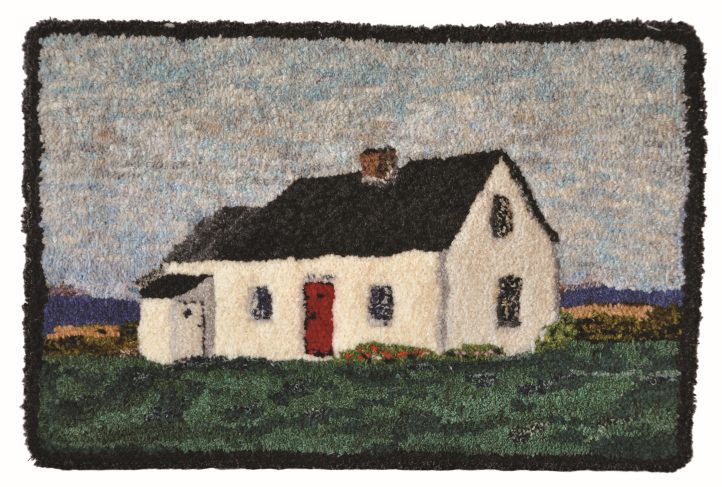
MacKenzie Farm House, 8″ x 13″, #3-cut wool on monk’s cloth. Designed and hooked by Margaret MacKay, Trenton, NS, 2007. The MacKenzie Farmhouse was built in the late 1800s and was a working farm for many years. On summer afternoons, the children from the summer cottages loved to watch Mr. MacKenzie milk the cows. Sometimes they would carry the pails to the house where Mrs. MacKenzie poured the milk into the separator. Dressed in her yellow-print apron, she always saved some milk and put it in a large metal saucer at the back doorstep. The barn cats knew the sound of the dish on the step, and within minutes, a circle of pink tongues were lapping up the milk. The cats then sauntered back to the barn to curl up for a late afternoon snooze. The farmhouse is now a summer home, which Margaret can see every time she looks out her back window. She purchased wool in order to capture the precise color of the sky. The rest of the rug was hooked from recycled wool. After hooking, the loops were cut and sheared, and the edges were embossed. Figuring out how to portray the shades of white and grey was one of her biggest challenges in completing this rug.
The scene on any hooked rug, not just those on our vignettes, is a frozen memory. But look deeper, and you will find that each memory has many layers. When the hooking began on the vignettes, our memories and stories unfolded.
Our collection of vignettes includes more than twenty-four pieces and has been shown at several community events. It has inspired more hooking ideas—Jimmy Murray’s fishing shed and the old canning factory are just two of the many that have been requested.
The heart and soul of any community is its people and its history. Our collection of little mats will continue to grow, and as it does, it will remind us of our rich heritage and the wealth of personal stories in the part of this world that we call home.
VIGNETTES AS FUNDRAISERS
If your hooking group likes to fundraise, then your own collection of vignettes could be reproduced for note cards or calendars. Most “click and drag” calendar programs use a 4″ x 6″ image so preplanning to use a 9″ x 6″ or 12″ x 8″ size (or any other combination of a 3 by 2 ratio) makes the process of enlarging or reducing the photos much easier. You can easily find services to turn the images of your rugs into cards, calendars, or anything else you can imagine. The Internet will provide several options; check with your local office supply stores and camera shops as well.
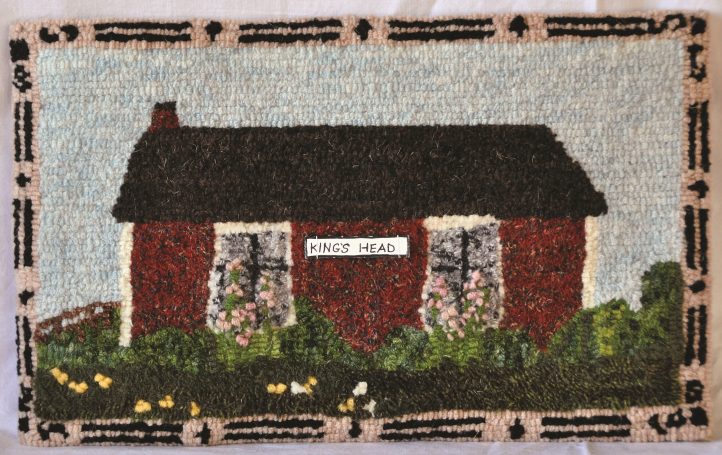
King’s Head School, 12″ x 7″, #5-cut wool on linen. Designed and hooked by Catherine MacLean, New Glasgow, NS, 2008. Catherine’s husband attended primary grades at King’s Head School in its last year as a one-room schoolhouse. In good weather, he and his sister raced home for lunch on their bicycles, waving to the cows in the pasture. Catherine sketched the school from an old black-and-white photo edged with a scroll border, which she incorporated into the vignette. The brick walls were hooked from a reddish-brown plaid skirt that Catherine wore as a child. The flowers are French knots.
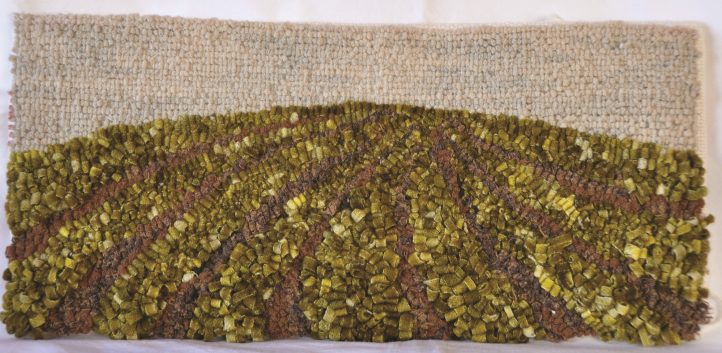
Seymour’s Potato Patch, 5″ x 9″, #3- and 4-cut wool on linen. Designed and hooked by Wendy Williams, Trenton, NS, 2008. Seymour was a local fisherman, farmer, and woodsman with a warm smile and a peppermint for any child he met. He rented neighboring fields to plant his vegetables. Seymour’s potato patch was a six-acre field belonging Wendy’s family. As a little girl she played in the rows between the long, furrowed hills of potato plants, and during the harvest, she and her brothers helped pick potatoes. Wendy’s mat is an abstract vignette portraying a unique view of rows of the potato field. She pulled the loops very high and very low to create the texture for the potato plants, a technique that she found difficult but ultimately rewarding.
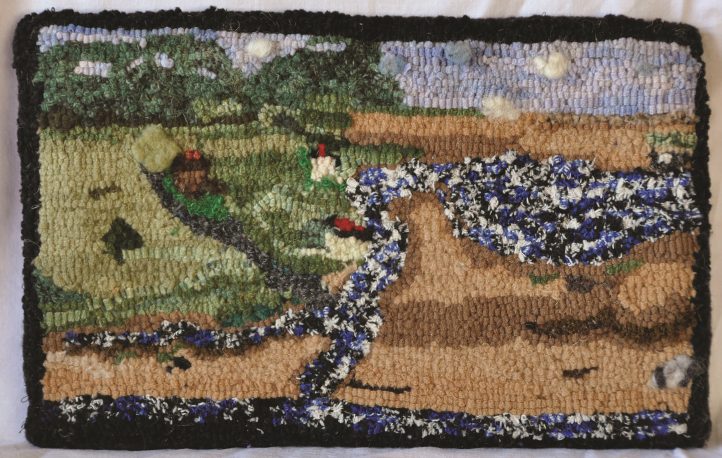
The Little Chance, 7″ x 11″, #4-, 5-, and 6- on burlap. Designed and hooked by Heather Coll, Trenton, NS, 2008. For the past 50 years, Heather has been walking along this stretch of beach—these days with her grandchildren and the dogs. She drew this scene from one of her fondest memories and then created a pattern for her mat. In addition to wool, Heather used yarn and fleece in the rug. The fleece gives the clouds a lighter feel than the wool used elsewhere. Capturing the full scope of such a large scene in a small mat was Heather’s biggest challenge.
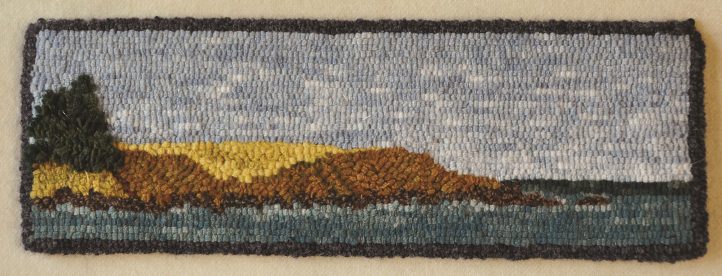
Black Point from the Inner Bay, 12″ x 4″, #3- and 4-cut wool on linen. Designed and hooked by Cheryl McLane, Trenton, NS, 2008. To capture the view of Inner Bay as Cheryl sees it required directional hooking. She hooked the sky and the water horizontally and she hooked the cliff on a diagonal. She used lighter blue wool near the cliffs to suggest waves and darker blue to suggest the calmer water farther out in the bay. Getting the blues to match her impression of the water was her greatest challenge. To add more dimension to the mat, Cheryl used high loops to hook the trees.
HARBOUR HOOKERS
Audrey Hemphill
Lynne Sheriden
Heather Coll
Cheryl McLane
Catherine MacLean
Wendy Williams
Aileen Ross
Carol Forbes
Ann-Renee Nowlan
Margaret MacKay

These are lovely! I will have to try a small vignette, it is a great idea.